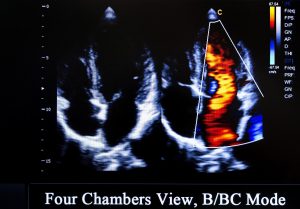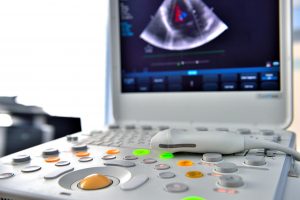The Matter of the Heart – Technology that Drives Echocardiography
Technological innovations have made it possible for cardiologists to effectively monitor and diagnose heart conditions without the need for invasive procedures. Ultrasound machines used in echocardiography have a number of cutting-edge requirements that allow them to assist medical professionals in diagnosing heart conditions quickly and accurately. The non-invasive procedure is easy on the patient and involves using sound waves to form an image of the patient’s heart on a display screen. This procedure reveals abnormalities that may be affecting the heart. Current computer technology has more capabilities than in the past, and has allowed for physicians to see 4D imageries with cross-sectional views of their patients’ hearts and a variety of key diagnostic modes to optimize the discovery and diagnosis. Safer and more accurate treatment plans can be better achieved.
 A good cardiac ultrasound machine requires a good transducer or probe that suits specific medical needs. Different types of ultrasound machines can transmit different frequency levels and the transducer can pick up the sound waves reflected back and relay them to the machine to be calculated and processed. The machine, usually controlled by a high performance computer or integrated motherboard, produces the resulting image of the pulse echo lines of the heart being inspected.
A good cardiac ultrasound machine requires a good transducer or probe that suits specific medical needs. Different types of ultrasound machines can transmit different frequency levels and the transducer can pick up the sound waves reflected back and relay them to the machine to be calculated and processed. The machine, usually controlled by a high performance computer or integrated motherboard, produces the resulting image of the pulse echo lines of the heart being inspected.
There are many considerations in selecting the right ultrasound machine and transducer to produce the outcome required for the job, including the frequency levels, size, dimensions, image format, etc. These essential components of an echocardiography machine, as well as its operations, are controlled by a computer – an embedded system, a medical panel computer or an integrated embedded motherboard. A cardiac ultrasound process relies on many factors to be successful. The machine needs to perform with speed, accuracy and reliability. The computer used to control the machine needs to have capabilities that include rapid data acquisition and processing, fail safe control of the machine, compatibility with its connected peripherals, high communications capabilities, software compatibility, support for high-resolution displays on its monitor for better image quality, etc. These requirements can only be met by the latest in computer technology designed for innovative medical device development.
Automatic optimization of high-resolution images and control of the machine via an intuitive user interface requires powerful processors, good connectivity to the health facility network and outside resources. Depending upon the features of the echocardiogram machine, some may require a high quality, medical-grade touch panel PC and some may also need to integrate a powerful motherboard into the system to control its operations. These components can support post-processing tools such as 4D Strain and 4D TEE to help optimize patients’ treatments and outcomes. These computers, medical panel PCs or motherboards must be able to support the increasingly complex requirements – from being able to display the visual of the organ or the region in 4D in real-time, to processing sound waves and translating the calculations into images. They should be able to store the images as well as transfer them quickly and securely. The most advanced computer technology can help improve the effectiveness of echocardiography applications and increase the accuracy of a diagnosis, and ultimately, save even more lives than ever before.
Embedded Systems and Industrial Motherboards for Echocardiography
 Different brands and price levels of echocardiography machines offer different capabilities. The need for a particular type and functionality of an echocardiography machine depends on medical facilities’ requirements. Premium machines offer the best image quality and require a high performance computer to drive high processing speeds. These machines rely upon advanced industrial computers or integrated motherboards to control the operations. Most of the premium cardiac ultrasound machines offer 4D imaging, many with advanced 4D quantifications and tools. They offer excellent cross-sectional views of the heart and surrounding regions. “Smarter” operational functions such as automatic image optimization and auto-measurement are commonly feasible.
Different brands and price levels of echocardiography machines offer different capabilities. The need for a particular type and functionality of an echocardiography machine depends on medical facilities’ requirements. Premium machines offer the best image quality and require a high performance computer to drive high processing speeds. These machines rely upon advanced industrial computers or integrated motherboards to control the operations. Most of the premium cardiac ultrasound machines offer 4D imaging, many with advanced 4D quantifications and tools. They offer excellent cross-sectional views of the heart and surrounding regions. “Smarter” operational functions such as automatic image optimization and auto-measurement are commonly feasible.
These embedded computers and motherboards offer interfaces or customizability for integrations with other key diagnostic elements of the echocardiography such as transducers. These transducers can have a variety of characteristics and offer different image formats. The types of transducers are usually selected to suit the acoustic windows (the region of the body it makes contact with). Its design, frequency, signal ratio, etc., are among key considerations for the device design. The large data volume generated and processed in real-time during an echocardiography diagnostic process requires the right computer as the brain of the device operations. The motherboards or systems selected to carry out these functions must be optimized in order to perform the function and deliver the results reliably. System integrators or medical device manufacturers often select motherboards or embedded computers that are feature-rich and developer-friendly, with ease of customizability and deployment to serve their specific needs.
Computers or medical touch panel PCs integrated to control these echocardiography machines are often required to offer high mobility. They are expected to be light and compact for easy maneuverability around space-constraint environments.
Medical-Grade Touch Panel Computers for Echocardiography
Depending upon the echocardiography manufacturer, design, functionality and the type of the ultrasound machine, a touch panel PC can be used as an all-in-one solution for the applications. Medical touch panel PCs offer UL60601-1 or EN60601-1 certifications. Most high quality ones offer high computing power, high resolution displays, IPX1 full antimicrobial enclosures, ingress protection and front bezel protection against blood and liquid spillage.
 More advanced, high-end ultrasound machines may require larger monitor sizes, i.e., 20 inches or higher while the portable ones require a much smaller display area. Both, however, have generally the same considerations for mobility of the device.
More advanced, high-end ultrasound machines may require larger monitor sizes, i.e., 20 inches or higher while the portable ones require a much smaller display area. Both, however, have generally the same considerations for mobility of the device.
Medical touch panel PCs act as a Human Machine Interface (HMI) with a brain, allowing medical professionals to carry out operations on its touch panel screen, such as selecting the view required for a particular diagnosis, controlling the workflow displays and carrying out measurements. These touch panel PCs can support varying requirements of image resolutions. A good medical panel PC can deliver up to 4K resolution images for better clarity of the views of the heart and its surrounding region. These all-in-one panel PCs can be customized to do the job required by an echocardiography machine to control the operation, offer HMI functions, process and display the images, store the data and images, and transfer them safely to the central medical record database for each patient for further evaluation.
Axiomtek Medical Solutions
Axiomtek offers fanless computers, medical touch panel PCs or industrial motherboards with desirable features such as rich I/Os, an easy-to-integrate design, high software compatibility and top-notch quality and reliability. Axiomtek’s industrial computer products have been selected by world-renowned medical device manufacturers, medical OEMs and ODMs for many complex medical applications.
Axiomtek offers engineering design and value-added services that help support medical device manufacturers on their device development quests. Axiomtek has more than 25 years of expertise in assisting medical device manufacturers and providing the latest in computer technology to the medical equipment industry.
Axiomtek’s UL60601-1/EN60601-1-certified medical touch panel PC line is designed to offer flexibility and scalability. The product line offers choices for size, computing power and features. Some of its key features include spill-proof antimicrobial enclosures, extensive and expandable storage and flexible communication options including WiFi, 3G/4G/GPRS and Ethernet connection for network communications. The touch panel PCs also provide options for resistive or projective capacitive touch screens. Their user-friendly designs offer front panel interfaces and on/off switches. Axiomtek’s medical panel PCs are made for ease of customization for a wide variety of uses in the medical environment.
Axiomtek also offers a full range of embedded motherboards and embedded systems. These embedded motherboards and systems can handle complex operations. The motherboard product line has a comprehensive list of form factors. Each form factor offers comprehensive and useful features that make them suitable for a wide variety of medical device projects. Axiomtek’s motherboards and embedded systems offer rich I/O options, and are designed for ease of customization and integration. Scalable processors include the powerful multi-core Intel® Core™ i CPUs as well as the low power-consumption Atom® and Celeron® CPUs. Most offer flexible graphical interfaces. Some support dual independent displays of up to 4K resolution. Learn more.
Product Showcase
CEM511 – High Performance COM Express Type 6 Module
- Compact form factor module with 7th Generation Intel® Core™ i7/i5/i3 Processor
- Expandable with up to six lanes of PCIe
- Rich I/O features including four USB 3.0, eight USB 2.0, one LPC, one SPI and more
- Supports 4K resolution for graphics-intensive applications
CAPA500 – Advanced, Compact Embedded Motherboard
- 3.5-inch embedded SBC with LGA1151 6th/7th Generation Intel® Core™ i7/i5/i3 Processor
- Equipped with option of Intel® H110 or Intel® Q170 chipset
- Compact with three USB 3.0 and three USB 2.0 ports
- Supports triple independent displays through HDMI, VGA and LVDS outputs
eBOX560-512-FL – Ultra-Compact, IP40-rated Embedded System
- Fanless embedded PC with Intel® Core™ i5-7300U or Celeron® 3965U Processors
- Multiple I/O options with four USB 3.0 ports, two RS-232/422/485 ports, two Gigabit Ethernet ports and one PCI Express Mini Card slot
- Wide operating temperature range of -10°C to +55°C (+14°F to +131°F)
- Equipped with two HDMI ports that support dual independent displays with up to 4K resolution
MPC152-845 – Rugged 15-Inch Medical Touch Panel Computer
- EN 60601-1-certified fanless PC with dual-core Intel® Celeron® Processor N3060
- XGA TFT LCD display with a resistive touchscreen and 420 nits of brightness
- Equipped with IP65-rated front bezel to prevent damage from dust and liquid spillage
- Two PCIe Mini Card slots available for RFID, 3G, Bluetooth or Wi-Fi connection
Contact us via email at medicalsolutions@axiomtek.com, or call 1-888-GO-AXIOM (1-888-462-9466) for more information.

